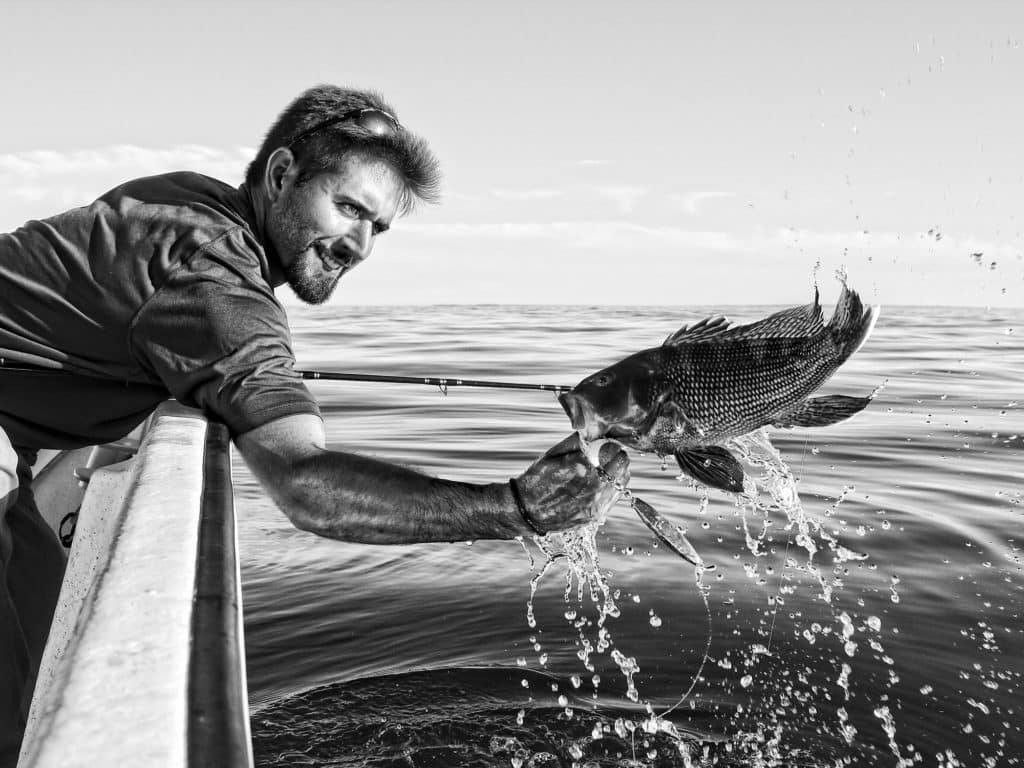
Rising Star
“Get ready, we’re almost there,” I said as I glanced over my shoulder at the small waves astern and reconfirmed with my chart plotter. Sean Callinan and I were drifting a conveyor belt of sorts, one of many in our home waters of eastern Long Island Sound, where an approaching rip — more a series of telltale riffles — over a reef 63 feet below forecast the bite just before we reached it.
I’m on!” replied Callinan as he set the hook. “Feels like it has some weight to it.” About 30 seconds later, which seems like forever when your buddy has already hooked up, I felt a hard tug on my line. I prayed it wasn’t a rock and immediately set up on my own fish.
By the time we drifted into the rougher water, we had battled two big sea bass to the boat. Callinan’s hit the teaser above the lure, while mine grabbed my shiny jig below. “It’s going to be ceviche tonight,” said Callinan as he unhooked and admired his prize knothead. “And you say I have climate change to thank for that?”
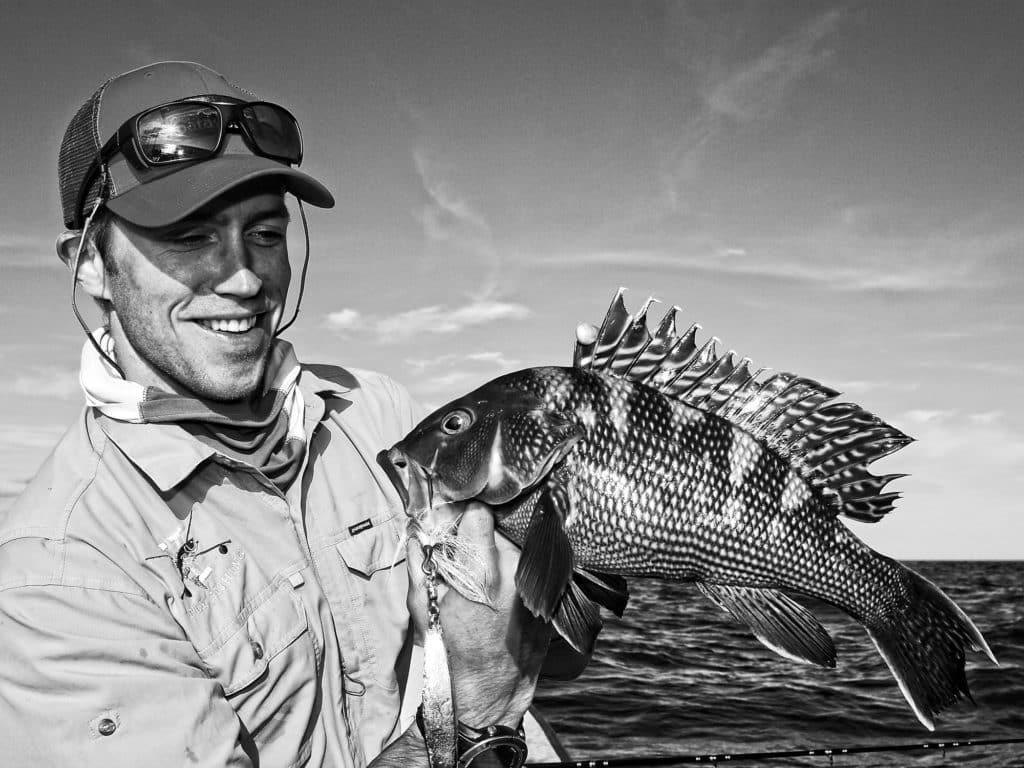
Mouthful
Warm Up
Most of us agree climate change is a bad thing, and it’s affecting many fish species in the western North Atlantic. According to NOAA Fisheries, as the waters warm, populations shift northward. For bottom anglers in southern New England, however, this has meant a significant increase in black sea bass, which were once most prevalent off North Carolina, but they’re now regulars as far north as the Gulf of Maine.
“The hot bottomfishing in our area is now focused on sea bass,” says Capt. Q. Kresser, manager at River’s End Tackle in Old Saybrook, Connecticut. “We’re seeing numbers and sizes of these fish like never before. Beginners and pros alike target them with great success, which comes at a perfect time when other bottomfish species are declining. Sea bass are aggressive, fight well and are excellent eating.”
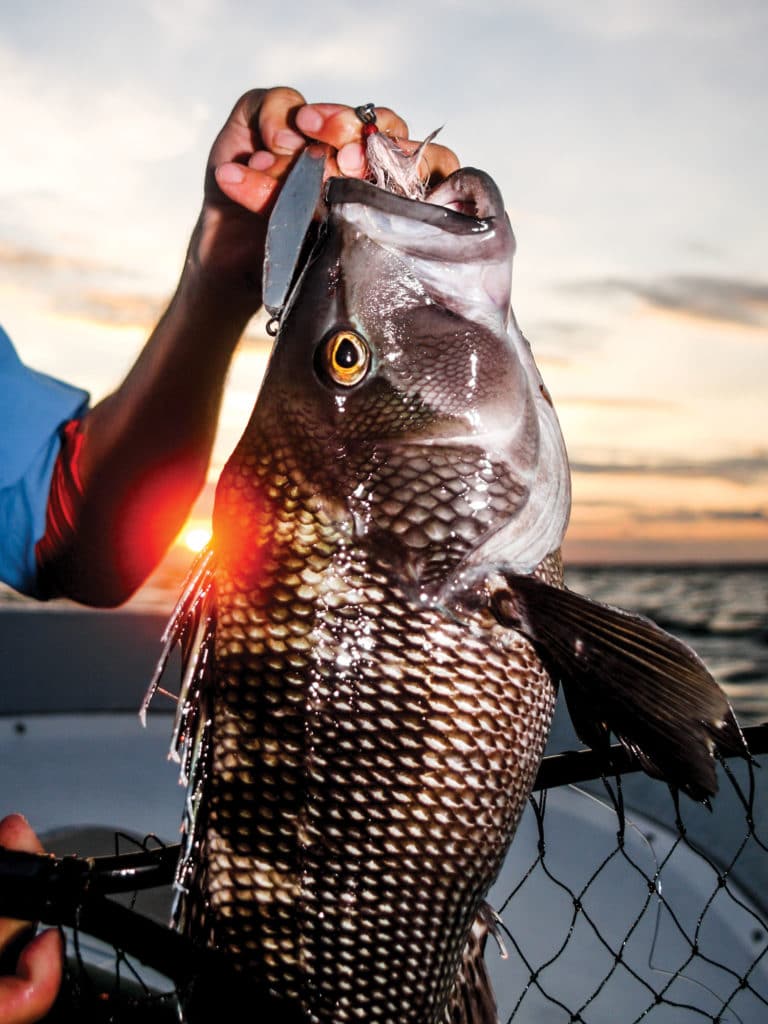
Classics
Almost any deep structure from eastern Long Island Sound through Rhode Island and southern Massachusetts is a potential sea bass jackpot. Sharpies closely guard their hot spots because a fleet of boats can quickly pick a patch of ground clean of big fish.
The good news is there are hundreds of productive spots in southern New England, many seldom fished. Your best bet is to study a chart and your depth finder to locate your own sea bass hangouts. Don’t just join the fleet.
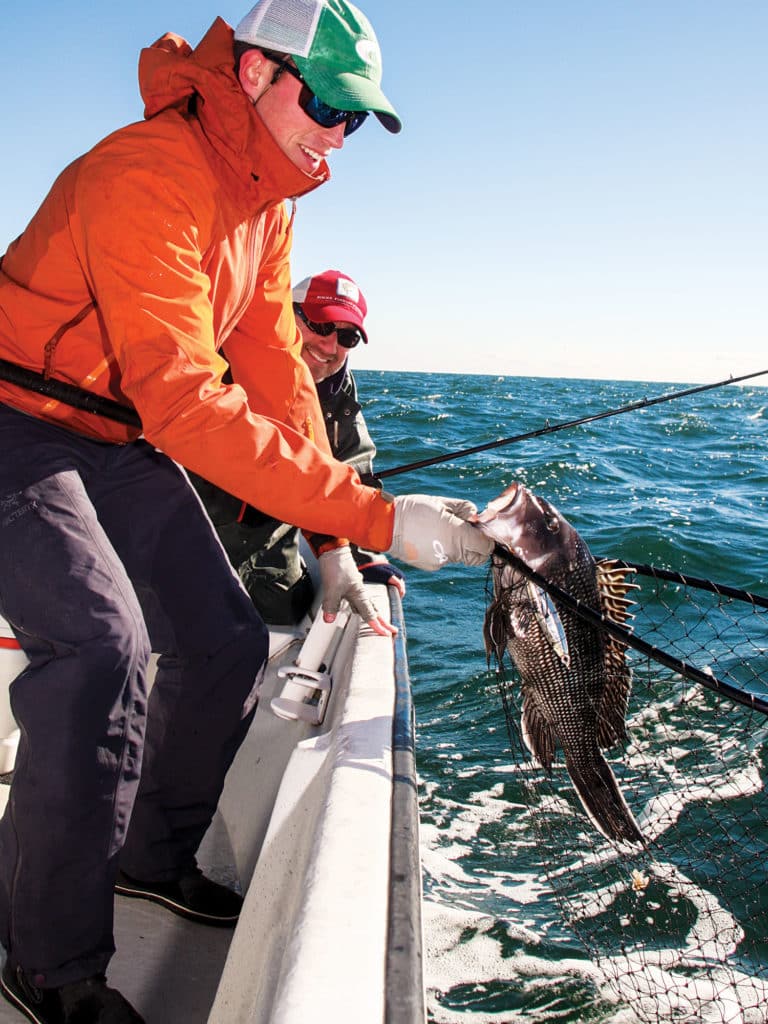
Deep Work
Diamond Jigs
I became sold on diamond jigs several years ago while targeting bluefish over reefs. I caught plenty of blues, but I also started landing large sea bass on heavy jigs sporting 8/0 hooks, especially when the bluefish were scattered or off the feed.
Humpback sea bass are not only aggressive, but they also have bucket mouths and willingly inhale large, fleeing prey or, in this case, diamond jigs.
Experts use the lightest jig possible given the wind, current and depth, which allows for the most action and feel. On offshore spots south of Block Island, for example, pros carry jigs up to 12 ounces. But in the waters of eastern Long Island Sound, a 6- to 8-ounce diamond is perfect because it weighs just enough to reach bottom in deep water and resembles prey species such as squid and herring.
“When fishing shallower spots inside Buzzards Bay,” says Capt. Ned Kittredge of Westport, Massachusetts, “3- to 4-ounce jigs are my preference.”
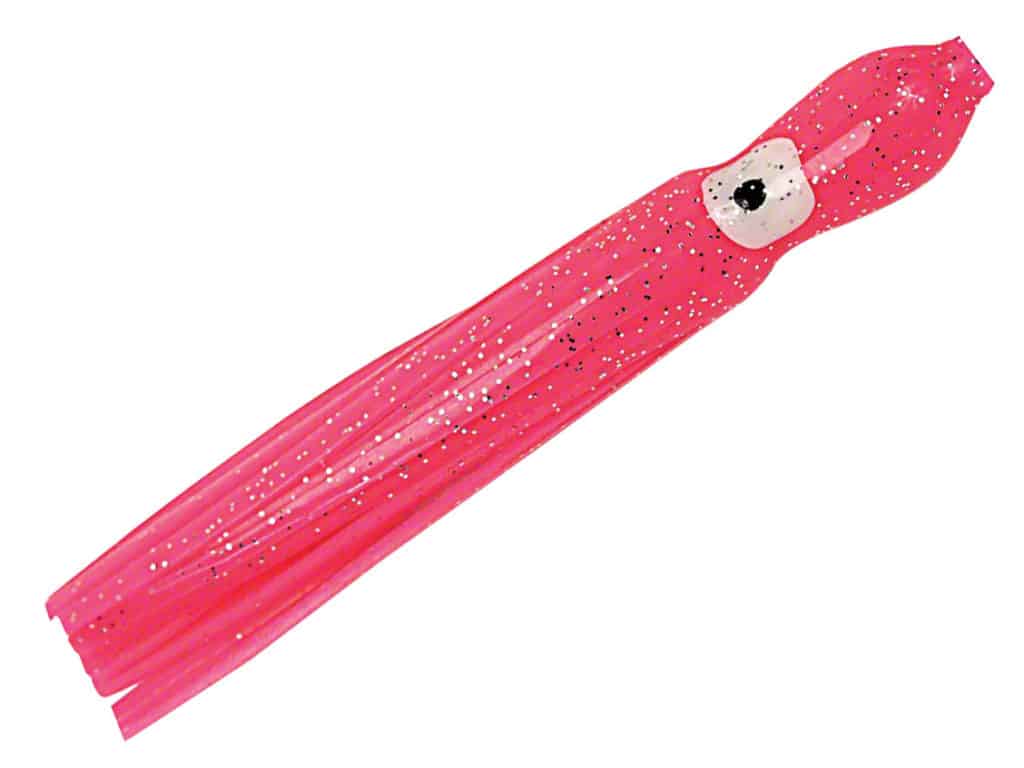
Sweetener
Bells and Whistles
Almost any diamond-jig hook works for big sea bass, although you may want to opt for 7/0 if you also expect stripers, bluefish, cod or pollock. Avoid using treble hooks over rugged structure because they hang on the bottom, are prone to foul hooking and create tangles.
Jigs often out-fish standard rigs for the biggest fish by keeping shorts and pesky porgies at bay, which can pick a high-low bait rig clean in seconds. Although sea bass will pounce on a naked jig, your catches may improve by sweetening the hook with a piece of squid, clam or fresh cut bait. Many experts add a teaser, such as a small plastic squid or a bucktail, on a dropper about 18 inches up from the jig.
“Lately, I’m fishing jigs without a teaser,” Kittredge says. “The bigger fish — the ones I want to catch — are extremely close to the bottom and hit the jig first anyway. When I use a teaser, I feel it accounts for more snags than a solo jig. And I personally don’t use bait anymore. These fish seem to be everywhere and hungry. If you don’t get a bite on the first drift or two, it’s time to look elsewhere.”
Reef Work
Rips form when a current plows over a reef, ledge or boulder field, and most of these structures hold sea bass all season. To find reefs, check your charts for contours where the depth rises and falls abruptly. Some reefs are marked by navigational aids and are easy to find while others aren’t. The unmarked reefs are often more productive because they receive less pressure.
Once you arrive at promising structure, motor up-tide of the rip while watching your depth finder. At the point where the reef levels off, stop the boat and let the current pull you back toward it. Immediately drop your jig overboard and start working it, which you should continue doing until you reach the crest of the reef or rip line. Plan your trips within about an hour of either side and through slack tide. Bluefish are less active then, jigs are easier to fish properly, and sea bass turn on during slower current periods.
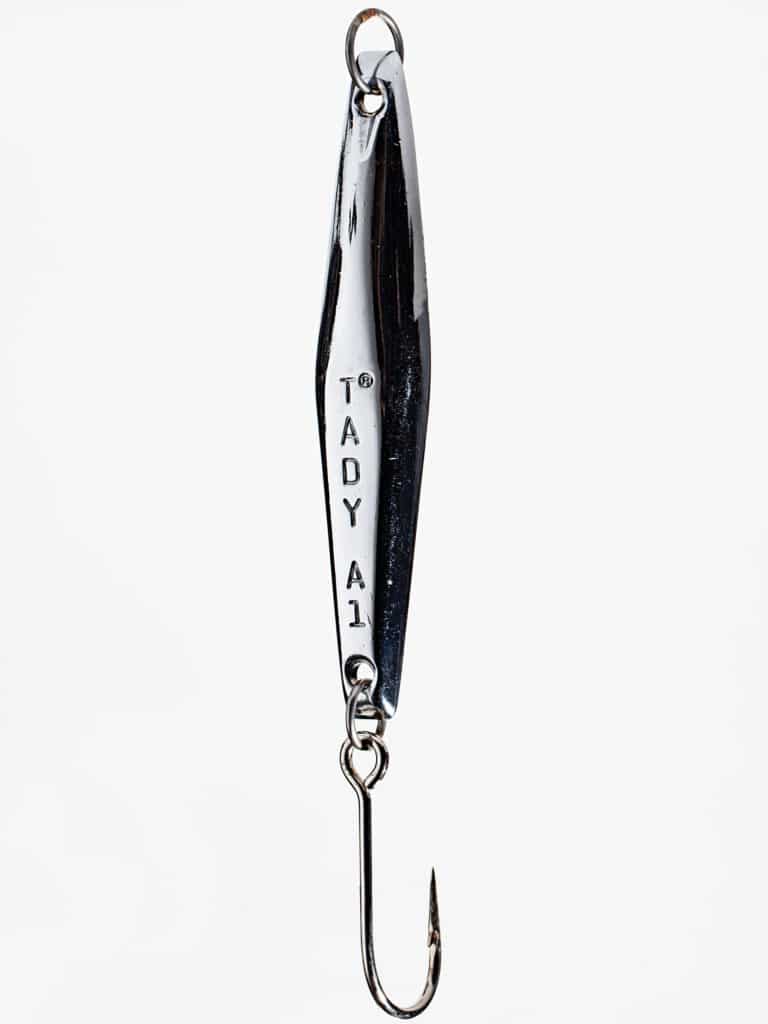
Alternate Option
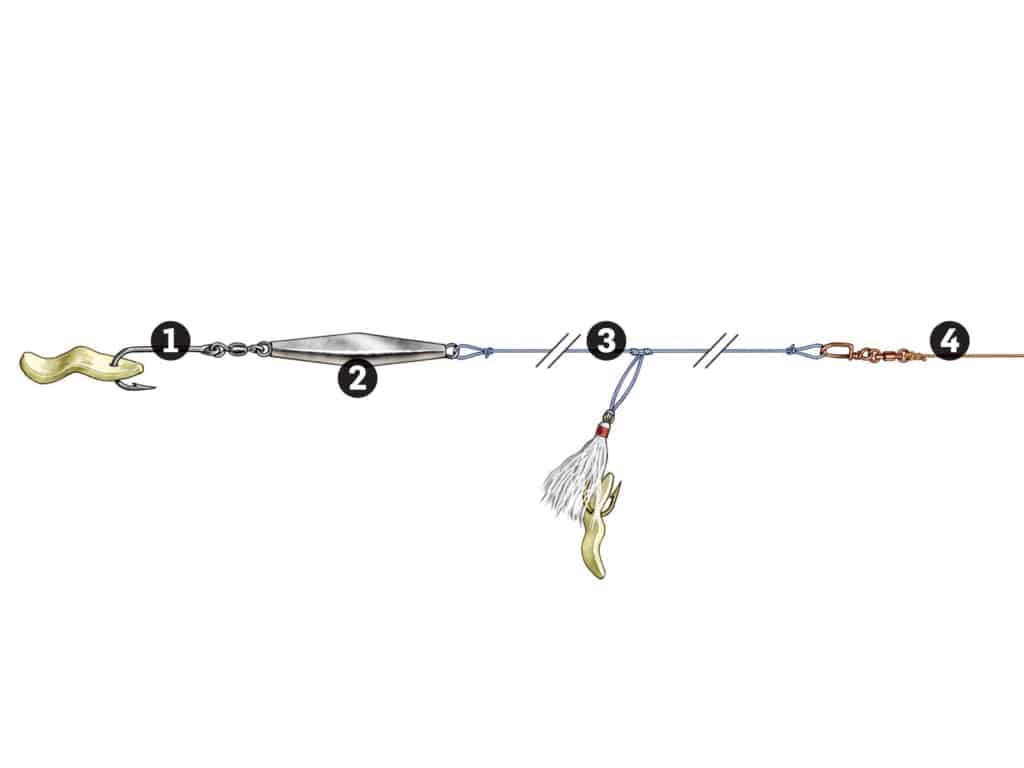
High-Low
Hot Action
There are many ways to work a diamond jig, depending on the species you’re targeting. The right technique is subtle action, keeping the metal bouncing along the bottom as if tending a sinker, using short 8- to 12-inch strokes to impart motion like a baitfish fluttering just inches off the bottom.
Expect to hang up occasionally and maybe lose a jig or two, but that’s worth the reward. With a diamond jig, the drop is as important as the lift. Because of its tapered shape, it flutters sideways toward the bottom, an action that resembles a wounded or spawning baitfish. Create this motion by dropping the rod tip. If you lower the tip too slowly, the resistance stymies the diagonal fluttering motion.
“It’s important to keep your jig near the bottom,” says Kittredge, “no more than a rod tip off the bottom, imparting a short but exact and fairly swift jigging action. These fish prefer structure and rarely venture too far up to feed. But don’t lose contact with the jig, as the strike often comes on the drop.”
SWS Tackle Box: Northeast black sea bass
Rods: 6- to 7-foot conventional, 12- to 25-pound or 15- to 30-pound-class, medium-fast action Reels: 3/0 conventional, levelwind reel with good drag Lines: 20- to 40-pound braid top shot over 30- to 50-pound mono backing **Leader: **24 to 36 inches of 50-pound mono or fluoro **Terminal Gear: ** 3- to 10-ounce (determined by conditions) diamond jigs; optional teasers off a dropper 18 inches above the jig **Baits: **Tip hooks with squid, clam, fresh cut fish or curly-tail grubs; teasers can also be dressed with slide-on bucktail or small white or pink soft-plastic squid. Hooks: 3/0 bait-holder hooks for teasers; 5/0 to 7/0 single hooks on jigs with bucktail optional
Tackle Talk
Tackle selection, like jig size, depends on where you fish. You can target sea bass in 60 feet in spring and summer and down from 130 to 200 feet in late fall.
“I jig sea bass with lighter gear than most people,” Kittredge says. “I can fish all day with such a setup and still land the occasional bass or bluefish that falls for the iron. Often, when there is a bluefish or striper blitz, you can catch jumbo sea bass close to the bottom under the blitzing fish.
Stick to the task at hand and resist the temptation to cast a surface plug at the blues. If you catch bluefish, you know they taste like bluefish, but when you catch the sea bass, they taste like lobster.”
That last pair of humpies limited Callinan and me out for the day, just in time before the current reached unfishable strength. When used properly, diamond jigs are our go-to lure to cull cows from the herd.









